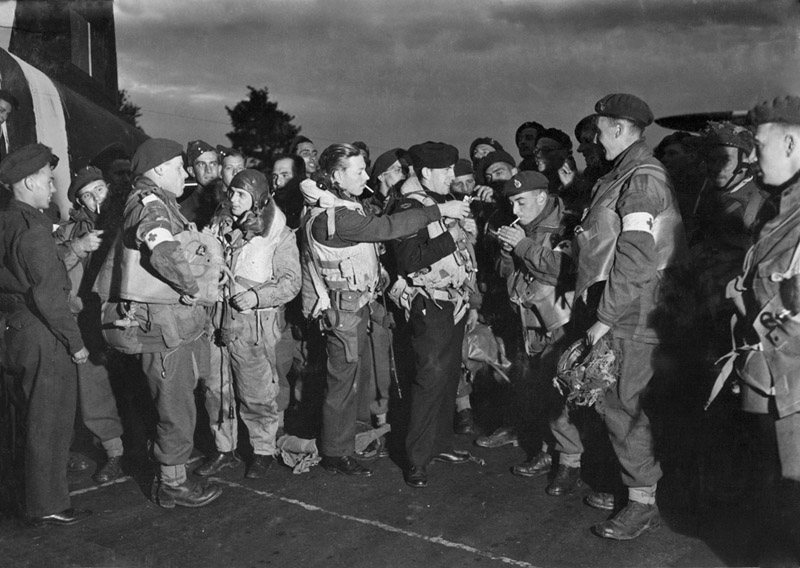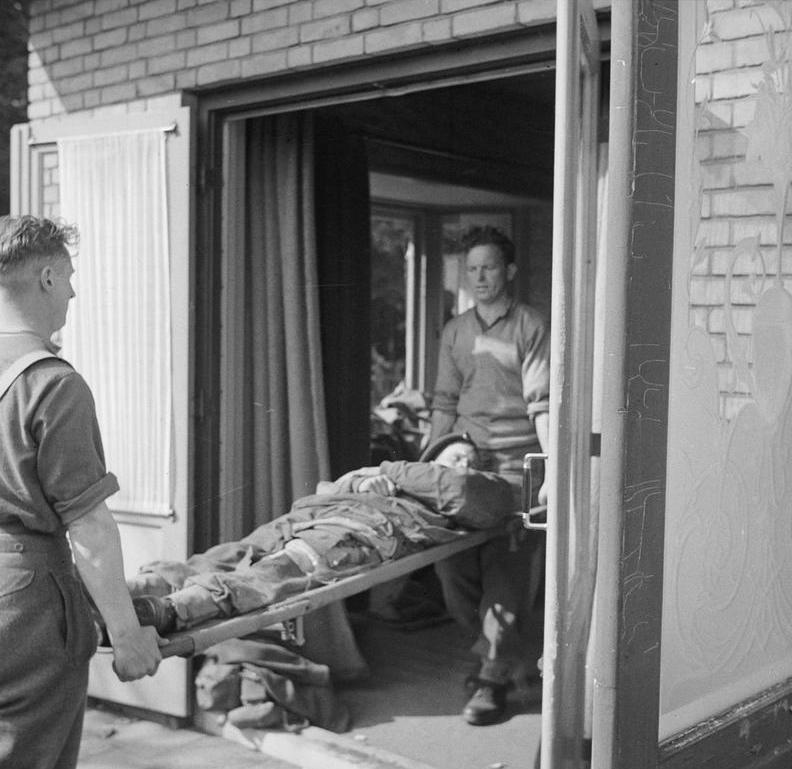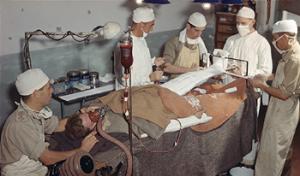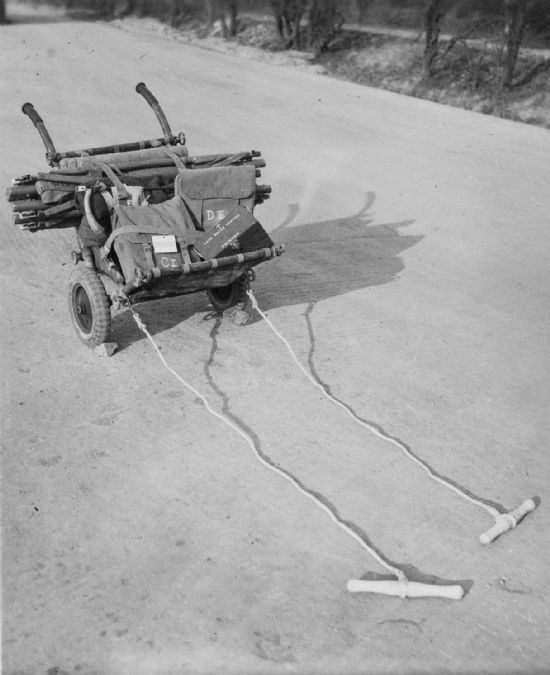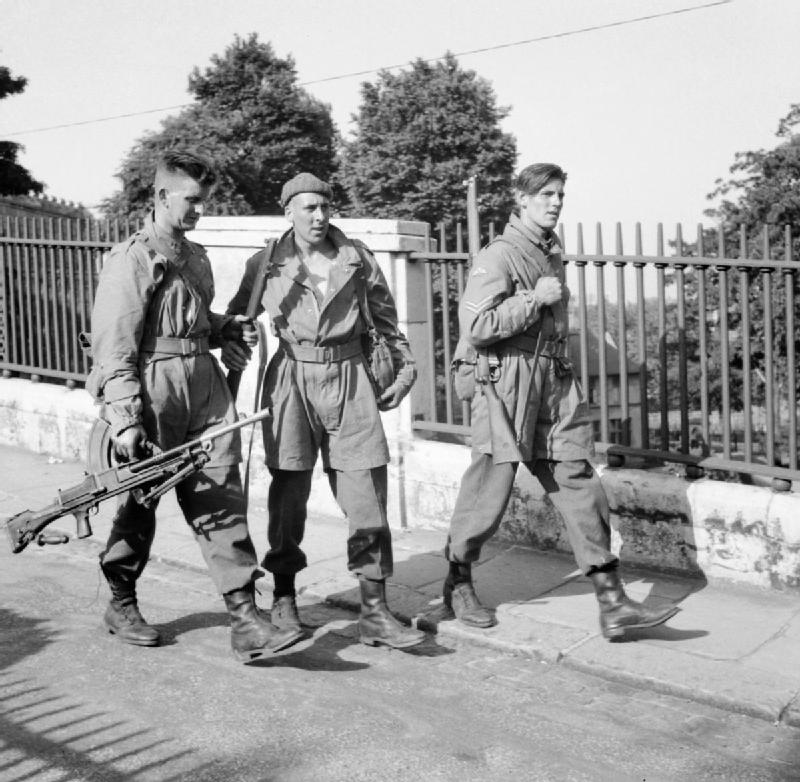|
225th Parachute Field Ambulance
The 225th (Parachute) Field Ambulance was a Royal Army Medical Corps unit of the British airborne forces during the Second World War. When raised the Field Ambulance was assigned to the 5th Parachute Brigade, which was part of the 6th Airborne Division. As such they participated in Operation Tonga, part of the Normandy landings. The unit remained in France until September 1944, when they were withdrawn back to England to rest and rebuild. They then took part in the last and largest airborne mission in the war, Operation Varsity, the River Rhine crossing in 1945. After the war in Europe ended they were sent to the Far East for operations against the Japanese however the war ended before they could be deployed. Instead they were sent to Malaya and Singapore to assist in the restoration of British control. Later in the year they were sent to Java, where the brigade had to maintain law and order until a Dutch force could arrive to relieve them. The Field Ambulance then returned to S ... [...More Info...] [...Related Items...] OR: [Wikipedia] [Google] [Baidu] |
Cap Badge
A cap badge, also known as head badge or hat badge, is a badge worn on uniform headgear and distinguishes the wearer's nationality and/or organisation. The wearing of cap badges is a convention commonly found among military and police forces, as well as uniformed civilian groups such as the Boy Scouts, civil defence organisations, ambulance services (e.g. the St. John Ambulance Brigade), customs services, fire services etc. Cap badges are a modern form of heraldry and their design generally incorporates highly symbolic devices. Some badges that contain images of Lions or other cats are sometimes informally referred to as Cat Badges. Instances in military forces British armed forces The British Armed Forces utilise a variety of metal and cloth cap badges on their headdress, generally on caps and berets. They are also worn on Sikh turbans. British Army In the British Army (as well as other Commonwealth armies) each regiment and corps has its own cap badge. The cap badge ... [...More Info...] [...Related Items...] OR: [Wikipedia] [Google] [Baidu] |
Java
Java (; id, Jawa, ; jv, ꦗꦮ; su, ) is one of the Greater Sunda Islands in Indonesia. It is bordered by the Indian Ocean to the south and the Java Sea to the north. With a population of 151.6 million people, Java is the world's List of islands by population, most populous island, home to approximately 56% of the Demographics of Indonesia, Indonesian population. Indonesia's capital city, Jakarta, is on Java's northwestern coast. Many of the best known events in Indonesian history took place on Java. It was the centre of powerful Hindu-Buddhist empires, the Islamic sultanates, and the core of the colonial Dutch East Indies. Java was also the center of the History of Indonesia, Indonesian struggle for independence during the 1930s and 1940s. Java dominates Indonesia politically, economically and culturally. Four of Indonesia's eight UNESCO world heritage sites are located in Java: Ujung Kulon National Park, Borobudur Temple, Prambanan Temple, and Sangiran Early Man Site. ... [...More Info...] [...Related Items...] OR: [Wikipedia] [Google] [Baidu] |
224th (Parachute) Field Ambulance
The 224th (Parachute) Field Ambulance was a Royal Army Medical Corps unit of the British airborne forces during the Second World War. The 224th Field Ambulance was converted to an airborne unit in 1942, and assigned to the 3rd Parachute Brigade, part of the 6th Airborne Division. They first saw active service in 1944 during the invasion of Normandy, and remained in France until September. They were then withdrawn back to England only to return to the continent at the end of the year in response to the German surprise winter offensive in the Ardennes forest. Their final mission of the war was the airborne assault over the River Rhine in 1945. They remained in Germany until the final surrender in May that year. After the war the 224th remained with the 6th Airborne Division, and following a brief period in England were sent to Mandate Palestine on an internal security role. In 1948, the field ambulance and most of the division was disbanded. Background Impressed by the success ... [...More Info...] [...Related Items...] OR: [Wikipedia] [Google] [Baidu] |
133rd (Parachute) Field Ambulance
The 133rd (Parachute) Field Ambulance was a Royal Army Medical Corps unit of the British Army's airborne forces during the World War II, Second World War. The 133rd (Parachute) Field Ambulance was formed in Palestine in January 1943, by the conversion of the 133rd Field Ambulance to parachute duties. It was then assigned to the 4th Parachute Brigade (United Kingdom), 4th Parachute Brigade, part of the 1st Airborne Division (United Kingdom), 1st Airborne Division. As part of the 1st Airborne Division it took part in Operation Slapstick, part of the Allied invasion of Italy. The unit returned to England at the end of 1943, to prepare for their next mission. That was operation Market Garden in the Netherlands. During the following battle of Arnhem, the division was destroyed only 2,100 men returning from the 10,000 that had started the mission. Amongst the men who remained behind from the 133rd were those men not already captured during the battle, who choose to remain behind with the ... [...More Info...] [...Related Items...] OR: [Wikipedia] [Google] [Baidu] |
127th (Parachute) Field Ambulance
The 127th (Parachute) Field Ambulance was a Royal Army Medical Corps unit of the British airborne forces during the Second World War. The 127th (Parachute) Field Ambulance (127 PFA) was originally a pre war Territorial Army unit and served alongside the 125th and 126th Field Ambulances, and 5th (Western) General Hospital RAMC (Now 207 "Manchester" Field Hospital) in the North West of England. It was converted to parachute duties, becoming the second parachute field ambulance in the British Army. As such it was assigned to the 2nd Parachute Brigade at the time part of the 1st Airborne Division. As part of the 1st Airborne Division it moved to North Africa in 1942, in preparation for the Allied invasion of Sicily. A lack of suitable transport negated their use it that campaign, but they did take the lead in Operation Slapstick, which was an amphibious landing at Taranto in Italy. Remaining in Italy with 2nd Parachute Brigade when the 1st Airborne Division returned to England, ... [...More Info...] [...Related Items...] OR: [Wikipedia] [Google] [Baidu] |
16th (Parachute) Field Ambulance
The 16th (Parachute) Field Ambulance was a Royal Army Medical Corps unit of the British airborne forces during the Second World War. The unit was the first parachute field ambulance unit of the British Army. Their first deployment was in Operation Torch the Allied landings in North Africa. This was followed by Operation Fustian during the Allied invasion of Sicily. Their third mission was Operation Slapstick, a seaborne landing at Taranto in Italy. The 16th (Parachute) Field Ambulance then returned to England to prepare for operations in North West Europe. Their next and final parachute landing was in September 1944, during the Battle of Arnhem. In the battle the 1st Parachute Brigade landed on the first day and the 16th (Parachute) Field Ambulance established at dressing station in a local hospital. Within days the location was overrun by the Germans and the majority of the field ambulance went into captivity as prisoners of war. In 1945 it was reformed and took part in Op ... [...More Info...] [...Related Items...] OR: [Wikipedia] [Google] [Baidu] |
195th (Airlanding) Field Ambulance
The 195th (Airlanding) Field Ambulance was a Royal Army Medical Corps unit of the British airborne forces during the Second World War. The 195th was the second airlanding Field Ambulance formed by the British Army. Once raised it was assigned to the 6th Airlanding Brigade, which was part of the 6th Airborne Division. It accompanied the brigade on operations, seeing service in the Normandy landings in 1944, and the River Rhine crossing in 1945, after which they remained in Germany following the advance until the end of the war. At the end of May 1945, the 195th was withdrawn back to England, but by the end of the year had moved with the 6th Airborne Division to the British mandate of Palestine in an internal security role. The 195th served in Palestine until the 6th Airlanding Brigade was disbanded. Background Impressed by the success of German airborne operations, during the Battle of France, the British Prime Minister, Winston Churchill, directed the War Office to investiga ... [...More Info...] [...Related Items...] OR: [Wikipedia] [Google] [Baidu] |
181st (Airlanding) Field Ambulance
The 181st (Airlanding) Field Ambulance was a Royal Army Medical Corps unit of the British airborne forces during the British Army during the Second World War, Second World War. The Field Ambulance was assigned to the 1st Airlanding Brigade, the glider borne element of the 1st Airborne Division (United Kingdom), 1st Airborne Division. Some men of the unit took part in the first parachute raid on the French coast in 1942. The unit then moved to Tunisia for operations in the Mediterranean theatre. During Operation Ladbroke, part of the Allied invasion of Sicily, a shortage of gliders resulted in only six, instead of the required thirty, being allocate to the Field Ambulance. Of those six, only one reached land the others crashed into the sea. They were next deployed during the Allied invasion of Italy in Operation Slapstick. Soon afterwards the Field Ambulance returned to the United Kingdom, then in September 1944, they landed by glider in the Netherlands. In the battle of Arnhem t ... [...More Info...] [...Related Items...] OR: [Wikipedia] [Google] [Baidu] |
1st Parachute Brigade
The 1st Parachute Brigade was an airborne forces brigade formed by the British Army during the Second World War. As its name indicates, the unit was the first parachute infantry brigade formation in the British Army. Formed from three parachute battalions as well as support units and assigned to the 1st Airborne Division, the brigade first saw action in Operation Biting – a raid on a German radar site at Bruneval on the French coast. They were then deployed in the Torch landings in Algeria, and the following Tunisia Campaign, where it fought as an independent unit. In North Africa each of the brigade's three parachute battalions took part in separate parachute assaults. The brigade then fought in the front line as normal infantry until the end of the campaign, during which they earned the nickname the "Red Devils". Following the Axis surrender in North Africa, when 1st Airborne Division arrived in Tunisia the brigade once more came under its command. The brigade's next mi ... [...More Info...] [...Related Items...] OR: [Wikipedia] [Google] [Baidu] |
Corps
Corps (; plural ''corps'' ; from French , from the Latin "body") is a term used for several different kinds of organization. A military innovation by Napoleon I, the formation was first named as such in 1805. The size of a corps varies greatly, but from two to five divisions and anywhere from 40,000 to 80,000 are the numbers stated by the US Department of Defense. Within military terminology a corps may be: *an military organization, operational formation, sometimes known as a field corps, which consists of two or more division (military), divisions, such as the I Corps (Grande Armée), , later known as ("First Corps") of Napoleon I's ); *an administrative corps (or Muster (military), mustering) – that is a #Administrative corps, specialized branch of a military service (such as an artillery corps, a medical corps, or a force of military police) or; *in some cases, a distinct service within a national military (such as the United States Marine Corps). These usages often ov ... [...More Info...] [...Related Items...] OR: [Wikipedia] [Google] [Baidu] |
War Office
The War Office was a department of the British Government responsible for the administration of the British Army between 1857 and 1964, when its functions were transferred to the new Ministry of Defence (MoD). This article contains text from this source, which is available under th Open Government Licence v3.0 © Crown copyright It was equivalent to the Admiralty, responsible for the Royal Navy (RN), and (much later) the Air Ministry, which oversaw the Royal Air Force (RAF). The name 'War Office' is also given to the former home of the department, located at the junction of Horse Guards Avenue and Whitehall in central London. The landmark building was sold on 1 March 2016 by HM Government for more than £350 million, on a 250 year lease for conversion into a luxury hotel and residential apartments. Prior to 1855, 'War Office' signified the office of the Secretary at War. In the 17th and 18th centuries, a number of independent offices and individuals were re ... [...More Info...] [...Related Items...] OR: [Wikipedia] [Google] [Baidu] |

.jpg)
